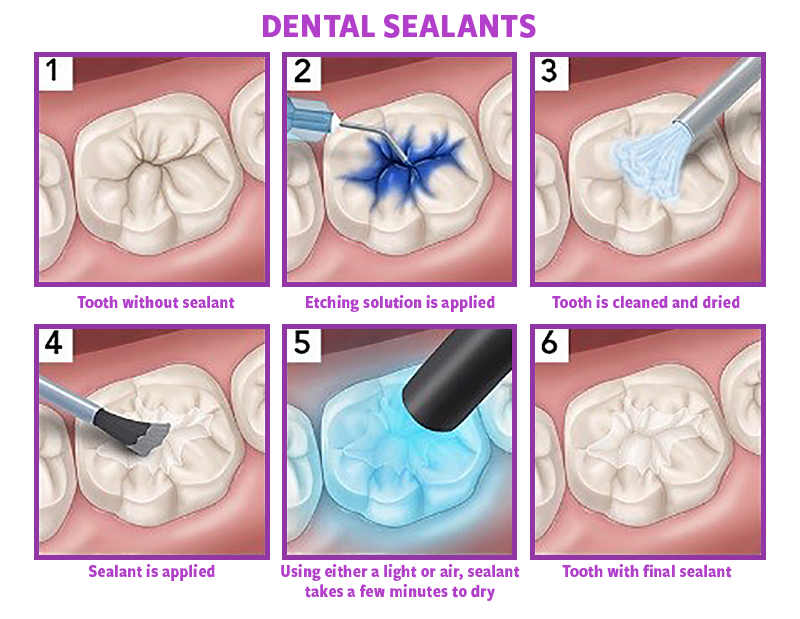The Preventative Power of Dental Sealants
Afraid of Collecting Cavities?
Reduce Plaque Build-Up and Protect Teeth from Decay With Dental Sealants
We all know that proper hygiene and routine visits to the dentist play a big part in the prevention of tooth decay. Unfortunately, other factors like genetics and the way our teeth are shaped, can increase the chances of developing cavities.
If you’re worried about tooth decay and are looking for an affordable preventative treatment, then dental sealants might be an option for you! In this blog, we’ll tell you what they are, how they work, and address other commonly asked questions regarding this popular dental procedure.
A Smooth Surface for Your Nooks and Crannies
Since the 1960s, dental sealants have been successfully used as a preventative measure against plaque build-up and cavities. Although relatively simple, they have been proven time again to protect against cavities up to 80% more effectively within the first two years of application.
Dental Sealants 101
What are they?
Primarily used to prevent tooth decay from damaging premolar and molar teeth, dental sealants (also known as pit and fissure sealants) are a thin, plastic coating that is painted onto the chewing surface of the tooth. It acts as a smooth surface, preventing bacteria and food from becoming trapped in the divots and grooves of our teeth.
Can anyone be a candidate for treatment?
There is no age limit regarding dental sealants, however, they are most often used for children as their permanent teeth erupt in the back of the mouth. Sealants may benefit adults at risk for cavities due to deep pits or fissures. For the same reason, they can also be used on baby teeth – although this is less common.
How does the procedure work and does it hurt?
The procedure for dental sealants is easy, non-invasive, and most importantly – painless. After a tooth’s chewing surface has been properly cleaned, rinsed, and dried, the sealant is painted onto it. To help harden the sealant, a light is briefly shined directly on the tooth, forming a smooth, protective shield.
Answering Other Common Questions
Are dental sealants dangerous?
The only real danger posed by dental sealants is the slim possibility of allergic reaction. To avoid this, be sure you inform your dentist of any allergies you may have.
Typically, sealants are made with medical-grade materials such as plant/synthetic resins or glass ionomers which is a glass powder combined with a water-soluble acid. Sealants also contain small amounts of BPA, however, the American Dental Association (ADA) reports no evidence of BPA in dental sealants causing adverse effects on health.
Is it possible to remove a sealant?
A sealant may be removed if there is excessive wear or damage to it. Following removal and depending on your individual treatment plan, you may then have the option of either replacing it or having a filling, crown, or bridge added in its place.
How long do they last?
Dental sealants are designed to last up to ten years, but their actual lifespan depends on personal hygiene habits, diet, and daily wear-and-tear. On occasion, a sealant may fall off or become loose. Regular visits to the dentist help to prevent this and replace them when necessary.
What’s the difference between a sealant and a filling?
Where sealants are used primarily for preventative treatment, a filling serves to restore damage already done to a tooth. Depending on your treatment plan, sealants may be the most effective treatment for both your teeth and your budget.
Seal the Deal at Your Next Appointment
If you’re curious about dental sealants and would like to know if treatment is right for you, talk to us at your next appointment! Our dental care team will be happy to discuss all of the available options for your individual needs, either cosmetic, preventative, or restorative.
Is it time for a check-up?
Contact us today to schedule an appointment!
Other articles you might enjoy…
How to Prevent Childhood Tooth Decay
Cavities are one of the most common chronic diseases for children in the United States. Here’s how your child can avoid tooth decay.
Brushing and Flossing Correctly to Avoid Future Dental Problems
How to properly care for your teeth so your smile lasts a lifetime.
What to Know When Your Child Starts Losing Their Teeth
Do you know what ‘normal’ tooth loss looks like? Check out this informational guide that prepares you for the first meeting with the tooth fairy.











